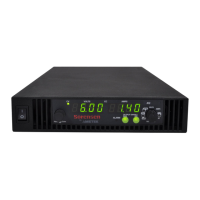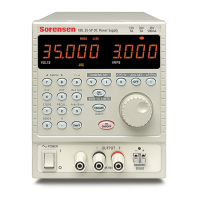Analog Programming (APG) and Isolated Analog Programming (ISOL)
4-2 M370430-01 Rev B
Introduction
The rear panel connectors J1 and J3 provide an option to control and
monitor the output of the power supply with analog signals. Connector
J1 provides a non-isolated analog interface where all signals are
referenced to the negative output terminal of the power supply.
Connector J3 is an isolated interface and also provides an isolated
auxiliary voltage output to aid analog programming.
Analog Programming (APG) of Output Voltage and Output
Current
Analog programming allows control of the power supply's output
voltage, output current or both to be controlled from analog input
sources. As the programming source is varied within the
configured analog programming range (2-10 volts/kΩ max), the
power supply's output varies proportionally over its output range.
For example, if you set the programming scale to 10 V voltage
source and apply 5 V to the programming pins, the power supply
will be programmed to 50% of the output capability for your power
supply.
While analog programming mode is configured, you will not be
able to make adjustments to the set points from the front panel or
through the remote interfaces.
The front panel will display AnPr in the output current display
when the 9-position mode control is turned to VOLTS or AMPS
positions for the parameter(s) that are configured to be controlled
by analog programming. If an adjustment of a parameter controlled
by APG is attempted using a SCPI command, a “-221 Settings
Conflict” error will be pushed onto the error queue.
Using analog programming requires that you make connections to
the Isolated Analog Programming Connector or Analog
Programming Connector on the rear panel of the power supply.
Depending on your model, see “Rear Panel Connectors on 850
Watt Models” on page 1-7 or “Rear Panel Connectors on 1500 and
1700 Watt Models” on page 1-9.

